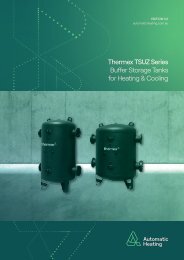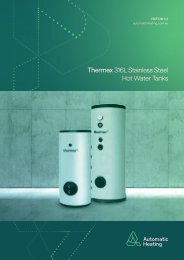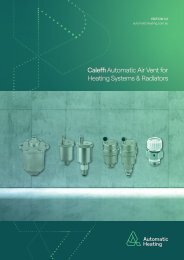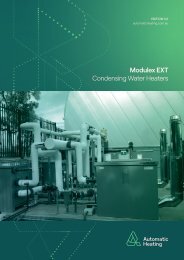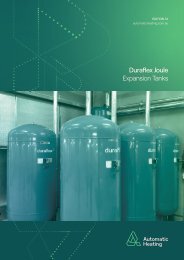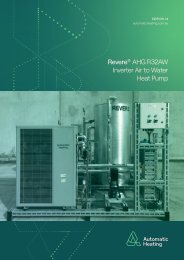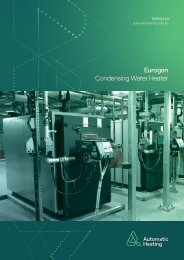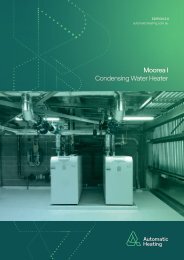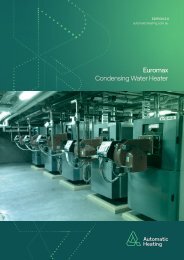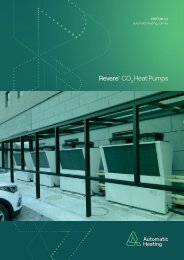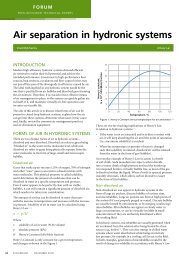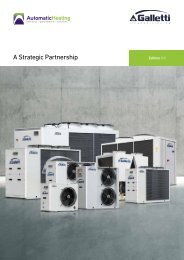AHG Solutions Guide_Edition 2.7
Full Product and Solutions Guide - Automatic Heating Global Pty Ltd
Full Product and Solutions Guide - Automatic Heating Global Pty Ltd
Create successful ePaper yourself
Turn your PDF publications into a flip-book with our unique Google optimized e-Paper software.
Contents<br />
Dirt and Air Separation<br />
Dirt<br />
Due to the nature of fluid systems, it is impossible to<br />
prevent dirt from accumulating in the system.<br />
Dirt can accumulate through:<br />
• Dirt via the filling and makeup water<br />
• Sludge as a result of corrosion of system components<br />
• Calcification when heating<br />
• System alterations and maintenance<br />
• Open header tanks<br />
Any hydronic heating or cooling or domestic hot water<br />
system works at optimal efficiency when it’s running with<br />
perfectly clean water. The introduction of dirt, corrosion<br />
by-products and other particulates are detrimental to the<br />
health and longevity of the components and system as a<br />
whole.<br />
The removal of harmful dirt and sludge is an important step<br />
in the flow of a water based heating or cooling system and<br />
can be managed by the inclusion of dirt and air separators<br />
sometimes in tandem and sometimes in combined units.<br />
Air and dirt work together to attack any water based cycle<br />
that is housed in materials that are liable to corrosion. Most<br />
people have seen the thick black sludge that collects in the<br />
bottom of domestic radiators that we see when the central<br />
heating is drained, this is generally produced by corrosion<br />
of the components. Air makes the corrosion possible and<br />
the by-products help keep oxygen present to react further,<br />
removing both has many benefits.<br />
Dirt Particle Sizes<br />
Performance Range of Dirt Separator<br />
Hair<br />
Magnetite<br />
Visible to Human Eye<br />
Heamatite<br />
Standard Filter Range<br />
Sand<br />
Welding<br />
Particles<br />
0.001 0.01 0.1 1 10 mm<br />
1 µm 1000 µm<br />
• Fewer instances of downtime<br />
• Increased lifespan of components and system as a whole<br />
• Lower fuel costs<br />
• Lower environmental impact<br />
• Quieter operation<br />
• Lower cost of maintenance<br />
• Decreased wear and tear<br />
EXPANSION &<br />
DEAERATION<br />
Particle Removal<br />
Specialist equipment can be incorporated into any system<br />
to alleviate if not totally eradicate the whole issue cost<br />
effectively. We have dealt with the problems that air brings<br />
to the table in another article but in basic terms while<br />
isolated in a vessel full of water, air will rise and dirt will<br />
sink. Reservoirs for the trapped gas and collected solids<br />
can be above and below the plane of the pipework and<br />
automatically released or collected and removed.<br />
Various methods can be used to encourage the quicker<br />
separation at the required point in the system. Mesh, pall<br />
rings and perforated tubing can disrupt the flow and cause<br />
the dirt and corrosion particles to drop to the bottom and<br />
the air bubbles to rise to the top.<br />
The dirt is periodically decanted off as sludge and disposed<br />
responsibly where as the gases can be bled continuously<br />
and released to the atmosphere.<br />
193



